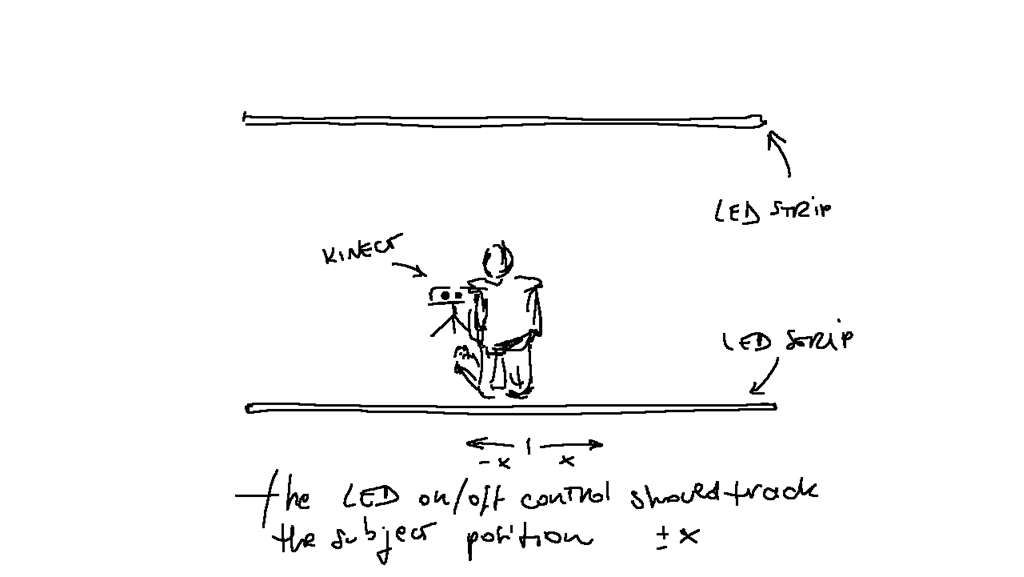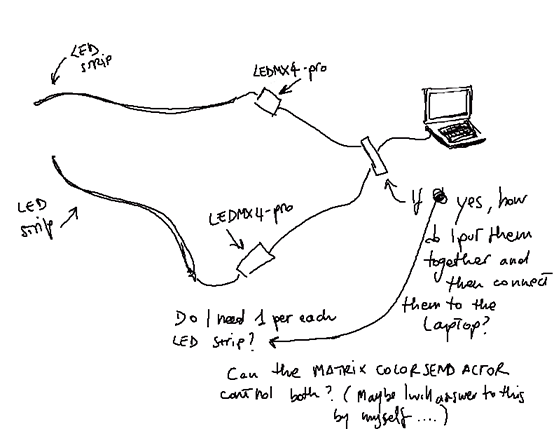LED System controlled with blob track through a Kinect in Isadora
-
Hello,
I would like to control a Pixel LED strip while tracking a subject (see picture below)

I would like to use the camera of the kinect to blob track the subject in +- x and switch off the LED relative to its position.
I know the camera of the kinect is seen by Isadora and I wondering if there is a special setting of the actor I should take into consideration.
Also, would this LED strip (see link below) work with this LEDMX4 work?
https://dmxking.com/led-pixel-control/ledmx4-pro
The color would stay constant and I would only like to control the intensity of the whole strips and in certain moments to turn off the ones next to the subject.
Any advice, suggestion or feedback would be much appreciated.
Thanks
Elena
-
I would start with artnet: https://support.troikatronix.com/support/solutions/articles/13000042898-isadora-2-artnet-plugins & https://support.troikatronix.com/support/solutions/articles/13000042899 There is a patch you can download and explore too within the second link above.
I cant comment on the links as LED and lighting is not really my *thing* - sorry.
-
Thank you Graham.Yes I have also the patch we worked on with Ryan at the Werkstatt. I just need to figure out the move with the HW so I can buy and start testing.
ThanksElena
-
the led strip should be fine with the dmxking controller. I use this same controller regularly.
The easiest way to achieve what you want to do would be to use the pixel mapping feature of isadora.. you may not even need blobs or kinect tracking.
Take a look at the matrix color send actor.
It will allow you to output a cross section of video direct to your leds..
-
I'm travelling today, but would be happy to help you further once I am home again.
-
Thank you. I will take a look at that in the meantime.
What is really important for me right now to be able to start is:
Can 1 ledmx4-pro control 2 LED strips, one for the top, and one for the bottom of the structure?
How do I go from the LEDmx4-pro to the laptop? CAuse if I need two of them, I might need something in between the two controllers and the laptop.

Happy to wait....
Thanks
Elena
-
Hi the LEDmx Pro has four connection points for led strips. The unit I use has a network interface.
best wishes
Russell
-
Thank you @bonemap
-
Hello,
I cannot understand if the LeDMX4Pro allows enough pixels to allocate the two strips.
Here is what I have got from the LeDMX4-Pro description- Up to 680 RGB pixels or 512 RGBW pixels per output spanning 4 DMX universes (2720 RGB pixels / 16 universes per board).
- Up to 340 16bit RGB pixels or 256 16bit RGBW pixels per output. Requires firmware 3.3+
- Automatic RGB / RGBW order correction and additional pixel re-mapping features.
- Per pixel intensity control for APA102/SK9822 utilizing the 5bit current pre-regulator. Requires firmware 3.3+
- Master Level control independent of incoming universe streams. Requires firmware 3.3+
- Flexible Full Mapping option for outputs permitting any start address and zig-zag corrections for RGB, RGB16, RGBW and RGBW16 pixel types..
Here is what I have got from the LED strip
Individually addressable. Full Color, Programmable LED Strip, WS2812B LED, WS2811 IC Built in 5050SMD.256 Brightness Display and 24-Bit Color Display.
With super bright SMD LED as light source, high brightness, low decay. Making LED screen, LED wall, billboard, apply to hotel, KTV, bars, outdoor advertising signs, Festivel Christmas or wedding decoration.They are 60 LED/m for a length of 5m
So, here is the numbers I ran:
60x5(meters)x3(RGB)=4500 pixels per output +60(position...?!?)
But the description of the LeDMX4-Pro says 680 RGB pixels per output.So am I calculating this wrong or what? Can anyone explain how should I run this process so I get it once for all.
Thanks
Elena
-
looks to me like you got the math wrong.
60x5 = 300 (rgb leds)
300x3 = 900 (DMX channels for RGB control)Each DMX universe has 512 channels.
So using 2 Universes you can control your 5m led strip.The LeDMX4 offers enough to handle both of your strips without any additional hardware (although you will need a ethernet router, since the LeDMX4 must connect to a router, and your computer to the same router)
note: I use a cheap D-link home wifi router, that cost me $10 from a second hand store
AND you need a power supplyI have not yet setup this device to try to use more than 2 universes on a single output (it says it can do 4), but I am running 2 Universes on each of the 4 outputs.
The DMXking configuration software is going to be your best friend getting this to work.
To start you don't even really need to use Isadora, as you need to work out the connections/addressing, and can use one of the utilities features (opens another window) that lets you send DMX out in a number of ways.. to a full universe or to parts. This will allow you to more easily see how/if the led strips are addressed correctly.
Once you know this information (and its saved to the LeDMX4 board) you can start to experiment with sending artnet to the same addresses.
note: Its possible the universe addresses will not match. NOT SURE THIS IS THE CASE, but it may be that the DMXking software is using 1 thru 15 where isadora is using 0thru 15.
Either way the output data on the Isadora Artnet actor helps make the selected universe easier to understand.Working out the addressing will probably be the hardest part of this, and may require some trial and error.
Also, once connected to the LeDMX board, and using the DMXking utility to send DMX to the led strips, you will need to send full white to all the LEDS (better to start with 25%, then 50%, then 75, then 100%)
This is so that you can see if the LEDs toward the end of the LED strips are getting enough power. Often, what you will see is that the LEDs toward the end of the strip are beginning to look orange, then red.. this is due to power issues.
If that is the case, you need to wire in 'power injection' along the strip and/or supply more amperage. The LeDMX4 pro supplies 5amps of power per output, but this may not be enough for your strips.
Your lights use: 18 W/ m, 0,3 W / LED
so 5 meters of these lights will require, 18x5 = 90 watts (best to add 20% for buffer) so make that 108 watts
With 2 of these strips running you are going to need minimum a 200 watt power supply. Thats a 40 amp (I would get 50) at 5v power supply. (for 2 strips... you may want double that if you want to extend this to use all 4 outputs at some point with more leds)You may want to consider using 12 or 24 v leds strips rather than 5v as they handle power loss over distance better (require less power injection).
But they also can't be directly controlled via 5v controllers like Arduinos etc..(in case you want that flexibility for the future)Sorry this is a bit of a ramble... I was remembering things as I wrote.
Let me know if you need more clarification etc.. -
@dusx said:
The LeDMX4 offers enough to handle both of your strips without any additional hardware (although you will need a ethernet router, since the LeDMX4 must connect to a router, and your computer to the same router)
Thank you so much, this is very helpful. I have several questions though and I am sure it is cause of my low experience. So I am going to have only 1 LeDMX4 for both the LED strips, correct? Then why can't I just connect the King to the laptop through ethernet cable?
Let's start with this as I am still waiting for the components to arrive.
Thanks
Elena
-
You can, but it requires 'harder' network config.
To get started it will be much easier to use a router... once working you can then remove the router and reconfigure the networking to be static if you like.
-
Ok great. Sorry to be pain but this is fine using only one LeDMX 4. Just because the production is spending money and I don't want to mess up. Thanks
-
This would work right? 8Port Network Switch 10/100Mbps Gigabit LAN POE Ethernet HUB Desktop-Adapter
-
Hi there @Elena,
You want a router not a network switch, you need an DHCP broker in your configuration to make sure that every single device gets an unique IP. Network Switches only work for static networks.
-
-
Thank you both for the patience. I know I am very annoying.
Would this work then? Router ASUS RT-N12 Wireless-N300
-
Yes. I beleive I have used the same model at one time also.
And your not annoying, this is a complicated thing to work out, especially the first time.
Have you found a power supply yet?
-
Ok thank you for confirming the router. So... for the power supplier, I have a 500mA which based on the numbers you ran above, doesn't seem to be enough.
Now, I don't know if I should go for 12-24 V LED and so also for the correspondent variant of the King.
I am going to use only 4m per strip, cause that is how much my length is, but if you say I should just go for the 12-24V also to be able to keep it open also to future different applications...
So do I look for 200W/12V= 17 -> 20amp...? which is the highest amp for 12-24V?
Also I will need some cables extension cause I have to take both the strips, one at the top, one at the bottom, like in the first drawing up there... and connect them to the DMXking which will be somewhere around there... then I have to go to the router offstage and then to the laptop.
Also when you say power injection, does it mean I have to solder? Cause I don't have anything to do so...Thanks again for all your help
-
I would recommend reading this page.. it appears to be a pretty good overview of power injection. http://spikerlights.com/pwrinj...
Yes, you may need to soldier.
20 amps is not the max. It is simply the max that the ledmx4-pro can output ( 5 amps per channel) BUT you can connect, for example a 60 amp power supply to the ledmx4-pro. Only 20 amps will flow thru the ledmx4-pro the other 40 amps are still available for power injection. This is what I have typically done. You can run the positive and negatives from the power supply to the ledmx4-pro and to the + - lines of the led strips every X number of leds (this is your power injection).
You can do this easily with 1 power supply since the ground is common.
This gets slightly more complicated if you want to use multiple power supplies.ļ